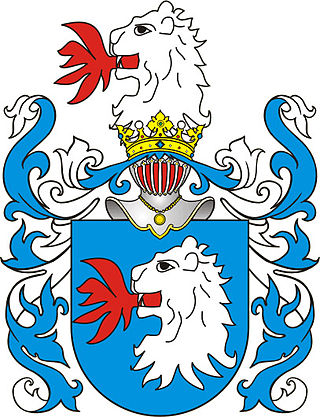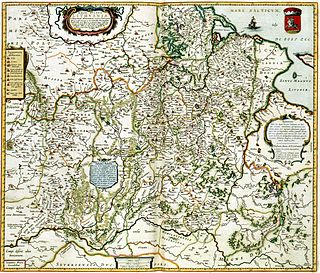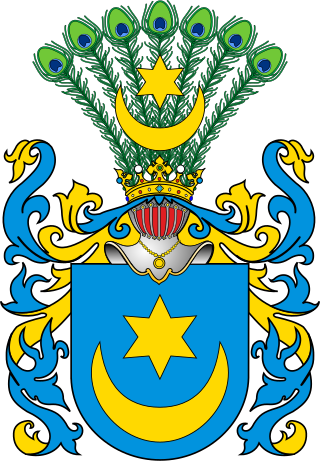
Tomas Venclova is a Lithuanian poet, prose writer, scholar, philologist and translator of literature. He is one of the five founding members of the Lithuanian Helsinki Group. In 1977, following his dissident activities, he was forced to emigrate and was deprived of his Soviet citizenship. Since 1980, he has taught Russian and Polish literature at Yale University. Considered a major figure in world literature, he has received many awards, including the Prize of Two Nations, and The Person of Tolerance of the Year Award from the Sugihara Foundation, among other honors.

Kiszka was a noble family (szlachta) and one of the most powerful families (magnates) of the Grand Duchy of Lithuania in the Polish–Lithuanian Commonwealth. Originating from Mazovia, the family used the Dąbrowa Coat of Arms.

Jieznas is a small city in the Prienai district municipality, Lithuania. It is located 16 km (9.9 mi) east of Prienai along the northern shores of Lake Jieznas.
Edmundas Antanas Rimša is a Lithuanian historian, specialist of heraldics, sfragistics and genealogy.

Mykolas Kęsgaila Valimantaitis was a Lithuanian nobleman from Deltuva. He established the Kęsgailos family in Samogitia, where their power rivaled that of the Grand Duke of Lithuania. Mykolas Kęsgaila was the deputy of Ukmergė (1409–1412), Elder of Samogitia, and castellan of Vilnius (1443–1448). He was a father of Jonas Kęsgaila and Mykolas Kęsgaila the Younger.
Mykolas Kęsgaila was an influential Lithuanian nobleman from the Kęsgailos family. Together with his brother Jonas Kęsgaila, Mykolas dominated the politics of the Grand Duchy of Lithuania for three decades. Mykolas Kęsgaila was Chancellor of Lithuania (1444–1476), regent of Smolensk (1450–1458) and Voivode of Vilnius (1459–1476).
Stanislovas Kęstgaila (1503–1532) was a Lithuanian nobleman, son of Stanislovas Kęsgaila from the Kęsgailos family. Stanislovas Kęstgaila was the Elder of Samogitia (1527–1532) and castellan of Trakai (1528–1532). After marriage to Anna, daughter of Stanisław Kiszka, Stanislovas was the wealthiest magnate in the Grand Duchy of Lithuania.

Antanas Sutkus is a Lithuanian photographer.
Vytautas Kavolis was a Lithuanian sociologist, literary critic, and culture historian.
Sigitas Geda was a Lithuanian poet, translator, playwright, essayist, critic and a member of the Lithuanian independence movement, Sąjūdis, and of the Lithuanian parliament, Seimas.

Grinkiškis is a town in the Radviliškis District Municipality in Šiauliai County, Lithuania. It is situated on the Šušvė River. It is the seat of an eldership. According to the 2011 census, the town had population of 678.

The archaeological Neman culture existed from the 7th to 3rd millennium BC, starting in the Mesolithic and continued into the middle Neolithic. It was located in the upper basin of the Neman River. In the north, the Neman culture bordered the Kunda culture during the Mesolithic and the Narva culture during the Neolithic.

Jan Jurjewicz Zabrzeziński or Zaberezhsky was a noble of Leliwa coat of arms from the Grand Duchy of Lithuania, who achieved the height of his influence during the reign of Alexander I Jagiellon (1492–1506). He was duke's marshal (1482–1496), regent of Polatsk (1484–1496), castellan of Trakai (1492–1498), voivode of Trakai (1498–1505), and Grand Marshal of Lithuania (1498–1508). Zabrzeziński was married to Anna, daughter of Jan, elder of Brest and Hrodna.

Kristina Sabaliauskaitė is an art historian, doctor honoris causa of Vilnius Academy of Arts and one of the most prominent contemporary Lithuanian writers. Born in Vilnius, she has been based in London since 2002. She worked as a foreign correspondent in London and columnist for Lithuania's biggest daily newspaper until 2010.
Stanislovas Čiupurna was a Lithuanian noble, Court (1395–1407) and Grand Marshal of the Grand Duchy of Lithuania (1407–1411). As a close ally of Grand Duke Vytautas, he was one of the chief diplomats in the conflict over Samogitia with the Teutonic Knights.
Petras Jonaitis Mantigirdaitis was a prominent noble of the Grand Duchy of Lithuania. Grandson of Petras Mantigirdaitis, he first appeared in written sources in 1476 and reached his career high in 1490s when he was Voivode of Trakai (1490–97) and Grand Marshal of Lithuania (1491–97).

Undinė Radzevičiūtė is a Lithuanian novelist, a winner of the EU Prize for Literature in 2015.

St. Peter and St. Paul's Church is a Roman Catholic church in Varniai, Lithuania. Until 1864 the church was the cathedral of Samogitian diocese and the seat of Bishops of Samogitia.

Lithuania Ascending: A Pagan Empire within East-Central Europe, 1295–1345 is a Stephen Christopher Rowell's book published in 1994 by Cambridge University Press about the history of Lithuania of 1295–1345, centering on the expansion of pagan Lithuania in Eastern and Central Europe. It was republished in 1995, 1997, 2000. Osvaldas Aleksa translated the book into the Lithuanian language and it was published in 2001 by Baltos lankos.

The Brushed Pottery culture was a European Bronze Age archaeological culture found in present-day eastern Lithuania, Belarus, and southeastern Latvia. It succeeded the Neolithic Narva culture. It got its name from its characteristic flat-bottomed pottery, the outer surface of which is generally brushed with strokes, believed to be applied with bundles of straw or grass during pottery making.












